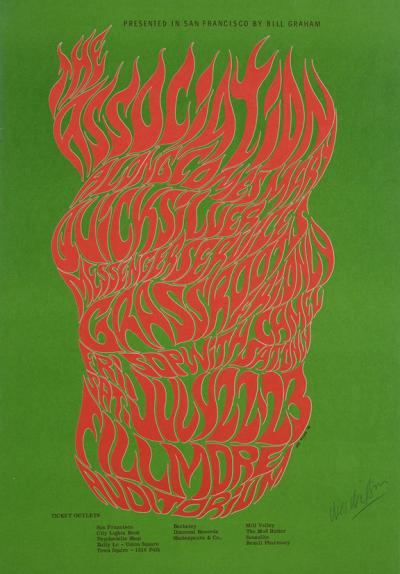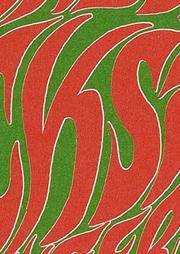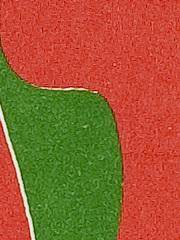
Association, Quicksilver Messenger Service, Fillmore Auditorium, San Francisco
Wes Wilson, United States
1966
20 1/8 in. x 14 1/4 in.
Partial gift of David and Sheryl Tippit; partial purchase with Marion G. Hendrie Fund; Florence & Ralph Burgess Trust; and other Denver Art Museum funds, 2009.515
© 1966 Wes Wilson
Wes Wilson was born in Sacramento, California in 1937. He got his start while working for a print shop in San Francisco, where he designed posters and handbills for early dance concerts. During the 1960s, he became the first artist to consistently create posters for the two main concert promoters on the San Francisco music scene-Bill Graham, who produced concerts at the Fillmore Auditorium and Chet Helms, who ran the Avalon Ballroom. One of the first projects to bring Wilson recognition was a handbill for the legendary Trips Festival, a three-day event that took place in San Francisco and set the stage for later dance concerts.
Wilson initially produced as many as six posters a month for the Fillmore and the Avalon. In 1966, when the pressure of designing multiple posters each week became overwhelming, he began working solely for Bill Graham. While Chet Helms loved to contribute to the poster-making process, Graham allowed Wilson the artistic freedom he desired. "Chet almost always had the theme already picked out, but with Bill, you could do your own thing, mainly because he was too busy to deal with you. He liked that I could do posters without him having to tell me anything." Despite the freedom that came with working for Graham, Wilson began to feel exploited and stopped producing posters for the Fillmore in 1967. Although Graham was building an increasingly profitable poster-selling enterprise, Wilson was paid only $100 per poster, without royalties. Wilson continued to produce posters for other venues, including the Avalon Ballroom. Today he creates artworks from his farm in the Missouri Ozarks.
Psychedelic posters were originally created as advertisements for dance concerts that took place in San Francisco from 1965 to 1971. The term "psychedelic" comes from the Greek psyche (mind) and deloun (make visible or reveal), and refers to the mind-altering effects of LSD, a hallucinogenic drug that was frequently used at these events. Designs for concert posters were a visual reflection of the experiences one might have at a dance concert. The movement, colors, and images all reflect the kinds of things that would appeal to a concertgoer's many senses. Posters were plastered on telephone poles and in store windows, and were often stolen by people who took them home to hang on their walls or refrigerators. "It was very disconcerting to poster a whole street and then walk back a few minutes later and discover that 90 percent had been removed. But I soon learned that a stolen poster carried home and pasted on a refrigerator reached the audience I wanted," said Helms.
Wilson was a part of the counter-culture that he was trying to reach out to, and was inspired by his personal experiences. "I imagine the posters were like some kind of imprint like a section of my mind at that time. And some of them were pretty weird, pretty strange," said Wilson. His designs set the style, capturing the full sensory experience of the dancehall environment and the visual distortions brought on by psychedelic drugs.
Details

Semi-Legible Text
Psychedelic posterslike this one were often filled with text that was difficult to read. “Well, it’s nice, but I can’t read it,” Bill Graham said about one of Wes Wilson’s poster designs. The artist replied, “Yeah, and that’s why people are gonna’ stop and look at it.” Wilson proved right. People often spent time looking at the posters and would actually sway back and forth as they tried “to follow the curvature of the words, the lettering,” noted Graham.

Lettering
Wilson drew his letters by hand to create three-dimensional, undulating shapes. This lettering style became characteristic of his early work. “I like to do my work freehand—no ruler and stuff. Just make it fit naturally. If I needed to make a letter a little wider, well, I would.”

Color
Wilson used “loud” or very bright colors to reflect the dancehall atmosphere. By placing the bright red and green next to each other, he created forms that seem to vibrate.

Movement
Wilson formed each letter so that it fit into the overall shape of the flames. The flowing lines evoke the energy and movement of the dancing crowd and the light shows that one would see at a concert.
More Resources
Quicksilver Messenger Service Live 1967
Footage of Quicksilver Messenger Service, a band listed on the poster, performing the song "All I Ever Wanted to Do" at the Monterey Pop Festival in 1967.
Audio Tracks from Bands Listed on the Poster
Websites
The Psychedelic Experience
The Denver Art Museum’s website accompanying the exhibition, "The Psychedelic Experience: Rock Posters from the San Francisco Bay Area, 1965–71," on view from March 21-July 19, 2009. You can access images of other posters as well as information about the artists and culture of the psychedelic scene. There is also information about the San Francisco Sound playlist available through iTunes.
Wes Wilson: Official Website of an American Artist
The artist’s website has biographic information as well as images of his work.
PBS Summer of Love
A website with resources related to the 2007 PBS documentary, Summer of Love, including video clips and a teachers guide.
Posters American Style
The Smithsonian American Art Museum’s online exhibition of American posters from the 1930s to the 1990s, which explores the strategies of commerce, propaganda, and patriotism. “The Process” contains an interactive exploration of how a poster is printed using offset lithography.
The Psychedelic 60’s: Literary Tradition and Social Change
An online exhibition from the University of Virginia’s Special Collections Library. The website includes information about poets, musicians and artists and images of their work.
The Chronology of San Francisco Rock: 1965-1969
The Virtual Museum of the City of San Francisco’s list of rock concerts from the time period and some links to band resources.
Books
Anthony, Gene. Magic of the Sixties. Salt Lake City: Gibbs Smith, 2004.
A collection of photographs by Gene Anthony, a well-known San Francisco photographer in the 1960s. The book also includes interesting essays on Haight-Ashbury.
Cabarga, Leslie. Logo, Font & Lettering Bible. Ohio: North Light Books, 2004.
A hands-on guide to the entire process of making logos, fonts and icons and references numerous poster artists.
Cronkite, Walter, and Tom Hayden, et al. The Sixties Chronicle. Lincolnwood: Legacy, 2004.
A good source for general information about the 1960s, including a timeline and short text about poster art, Allen Ginsberg, Ken Kesey, and the influential Beat Poets.
Graham, Bill and Robert Greenfield. Bill Graham Presents: My Life Inside Rock and Out. Massachusetts: Da Capo Press, 2004.
A loose autobiography of rock music promoter Bill Graham which covers his entire career through interviews with key people such as Jerry Garcia and Chet Helms.
Grunenberg, Christoph. Summer of Love: Art of the Psychedelic Era. London: Tate Publishing, 2005.
A guide to the art of the psychedelic era, including a wide range of images of posters, record covers, photography, and film, alongside a wealth of contextual material and a number of informative essays by leading academics, cultural theorists, and critics.
Grushkin, Paul. The Art of Rock Posters from Presley to Punk. New York: Abbeville Press, 1999.
A visual history of Rock and Roll, centering on the posters that were created to advertize musicians and concerts. The book also contains photographs of the poster artists, and the venues that displayed their work.
Lemke, Gayleand Jacaeber Kastor. The Art of the Fillmore, 1966-1971. California: Acid Test Productions, 1997.
An in-depth look at rock posters created for Bill Graham posters created exclusively for the San Francisco and New York Fillmore dance concerts.
Medeiros, Walter, Sally Tomlinson, D. Scott Atkinson. High Societies: Psychedelic Rock Posters from the Haight-Ashbury. San Diego: San Diego Museum of Art, 2001.
An overview of the Haight-Ashbury music scene, especially the Avalon and the Fillmore, including short biographies on different artists.
Perry, Charles. The Haight-Ashbury: A History. New York: Wenner, 2005.
A definitive book on the history of the San Francisco Haight-Ashbury culture.
Funding for object education resources provided by a grant from the Morgridge Family Foundation. Additional funding provided by the William Randolph Hearst Endowment for Education Programs, and Xcel Energy Foundation. We thank our colleagues at the University of Denver Morgridge College of Education.
The images on this page are intended for classroom use only and may not be reproduced for other reasons without the permission of the Denver Art Museum. This object may not currently be on display at the museum.
